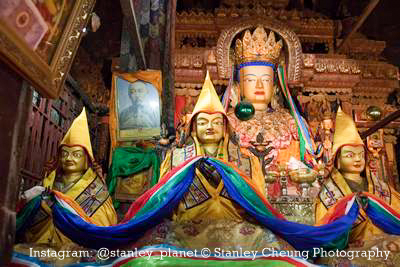Home > Destinations > Asia > Tibet > Festivals
TIBET FESTIVAL
Shoton Festival
30 August ~ 05 September, 2019
The Shoton Festival is one of the most popular traditional festival in Tibet. Shoton in Tibetan means "yoghurt banquet" and while the festival has myriad colorful aspects, its core lies in eating yoghut. It marks the end of the meditation season for monks. Dramatic Tibetan opera performances on Buddhism are held to mark the occasion and there are lots of ethnic Tibetan song and dance performances. The festival is celebrated annually in the month of August, or late in the sixth month or early in the seventh month of the Tibetan calendar.
It's a week long gala after and a major highlight is the unveiling of a gigantic Thangka painting of Goddess Tara on the first day. Hundreds of devotees visit Drepung to catch the first glace of the "Holy Thangka". It's believed that seeing the Thangka invokes divine blessings, Later, many traditional cultural events are held in front of Potala and local artists perform Tibetan opera every day at Norbulinka Squre. The Shoton Festival is an opportunity for Tibetans to take time off and enjoy family picnics. It's also a lovely time for shopping. Travellers visiting Tibet during Shoton get the chance to experience local culture up close.
Saga Dawa Festival
17 June, 2019
Saga means "the fourth" and Dawa refers to "month" in Tibetan. This festival is celebrated for an entire month and remains one of the most significant festivals in Tibet. The 15th day of the month is especially significant as it coincides with the birth of Sakyamuni (Gautam Buddha), his attainment of Nirvana (enlightenment) and stepping into Parinirvana (death). Tibetans believe that this day brings immense spiritual merits to the ones who embrace the Buddha's spirit of generosity, resist from eating meats and follow other pious practises. Cham dancing, monks chanting in monasteries, and other religious activities mark the occasion.
During the festival, hundreds of Tibetan circumambulate around the Barkhor, Tsekhor (Circuit around Potala) and Lingkhor. Monks secite prayers in the Assembly Hall across monasteries and serve butter tea during intermission. Tibetans line up in huge numbers at the Drepung kitchen to make donations for the monks. After visiting different monasteries, people head out for picnics and to restaurants. A major highlight is the late afternoon picnic held at the Dzongyab Lukhang Park at the foot of the Potala. It's like a yearly ritual and often visitors also join the crowd.
Tibetan New Year
05 ~ 07 February, 2019
Losar or Tibetan New Year is celebrated on the first day of the lunisolar Tibetan calendar, which corresponds to a date in February or March in the Gregorian calendar. Losar starts on the first day of the first month of the Tibetan Calendar, after the sighting of the new moon. This three-day festival is celebrated in a colorful way with prayers, folk dances, hanging prayer flags, passing of fire torches, and family reunions, Guests are entertained with delicious Tibetan dishes such as Dresi, Kabsay, Guthuk, different varieties of meat, bread and butter tea. People offer prayers at monasteries and present gifts to the monks.
On Day 1, all Tibetan Buddhists greet their respective gurus and wish each other. Offerings of barley seeds and tsampa are made at home altars with prayers for a good harvest. The women cook barley wine and a dish called Dresi. This day is called Lama Losar. On Day 2, the revered Dalai Lama exchanges greetings with national leaders. The second day of the festival is known as King's Losar. On Day 3, people make offerings to different Gods and protectors. Devotees visit monassteries, shrines and stupas, and also hang prayer flags. This day is called Choe-kyong Losar.
Gyantse Horse Racing Festival
20 ~ 25 July, 2019
Gyantse Damar Festival, also known as Gyantse Horse Racing Festival, is usually held in the fourth lunar month of the Tibetan calendar. The festival originated in the 15th century and has become a gala affair. Hundreds of horsemen dress up in smart costumes and also decorate their horses The festival initially started as a religious ceremony and later on entertaining events such as horse racing, yak racing, archery and wrestling were added. Now, it has turned into a huge carnival-like occasion, complete with Tibetan Opera, track and field games, ball games and Tibetan Opera. There is also a swap meet and an open market is held, where people swap merchandise. It offers a great chance to buy authentic Tibetan goods. One may even enjoy a delicious Tibetan food over a picnic with the locals.
The town of Gyantse is situated in a valley amidst high mountains, and the traditional way of life still holds sway here. During summer, the scenery in Gyantse is amazing with lush green pastures and flowers in full bloom. There are also several famous tourist sites in and around Gyantse, such as Yamdrok Lake, the Kumbum Stupa, Palkhor Monastery and Tashilhunpo Monastery.
A Word of Warning
Tibet is one of the most remarkable places to visit in Asia. It offers fabulous monastery sights, taxing high-altitude treks, stunning views of the world's highest mountains and fabled pilgrimage routes. The stunning scenery, friendly hospitality and experience of the their religion are the ingredients for a unique and rewarding adventure. However, with the sometimes-frustrating nature of the country, you will need to exercise patience and approach things with a sense of humor. If you expect everything to run as planned, if you want a predictable and consistent quality in your accommodation and transport - DO NOT travel to Tibet! If you love adventure and want a completely unique travel experience, we guarantee your journey will be a rewarding and memorable experience.
|
|---|
Newsletter Subscription: 訂閱最新旅遊資訊
Site Map · Privacy Policy 私隱政策(只附英文版)
© 2020 Exotic-Holidays.hk · All Rights Reserved.
![]()


